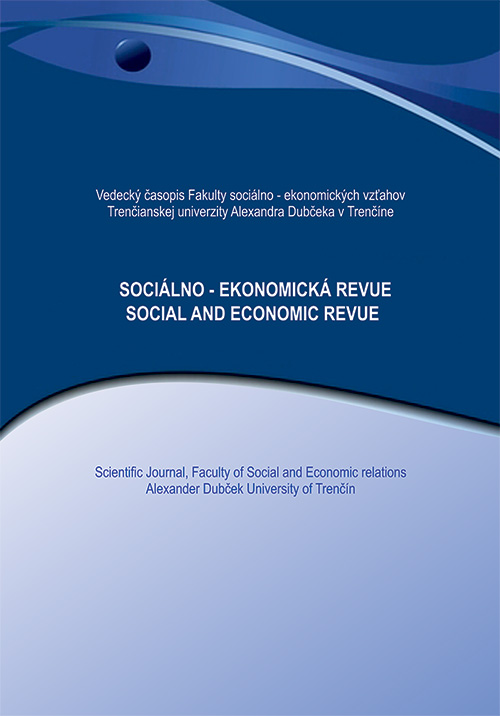THE EFFECT OF THE EXISTENCE OF CLUSTERS TO REDUCE REGIONAL DISPARITIES IN THE SLOVAK REPUBLIC
Regional differences in Slovakia, as well as in other EU countries, are becoming more and more observable. These economic, social and environmental differences show different forms. Different indicators are used to quantify these differences. The article deals with the issue of interregional differences and their measurement in the Slovak Republic at the level of NUTS 3 regions, using a composite indicator. The aim is to assess the level of regional disparities in relation to the existence of clusters in regional development. The basic sense of regional development is to sustainably improve the quality of life in the region. Achieving this basic goal requires a comprehensive approach to assessing regional differences. From the results of the analysis of the assessment of the reduction of regional disparities, it is not possible to state a statistically significant decrease in regional differences. A certain tendency was observable, but still there are still large regional differences in Slovakia, as in the economic, social and environmental spheres.
Release: 2018/4 Pages: 110-117 JEL classification: C34, C52, R23
DOI:
Keywords: Regional disparities. Composite indicator, cluster, beta-convergence
Section: PUBLIC ECONOMICS AND PUBLIC ADMINISTRATION, REGIONAL DEVELOPMENT
Contacts:
Dana Jašková, PhD., RNDr.
Alexander Dubček University of Trenčín
Faculty of Social and Economic Relations
Department of Economy and Economics
Študentská 2
911 50 Trenčín
Slovak Republic
e-mail: dana.jaskovanuni.sk
Literature:
Cherchye, L., Moesen, W., Rogge, N., Van Puyenbroeck, T. (2006). An Introduction to ´Benefit of Doubt´ composite indicators. Social Indicators Research, 82, 111-145.
Dawkins, C. J. (2003). Regional Development Theory: Conceptual Foundations, Classic Works, and Recent Developments. Journal of Planning Literature, 18(2), 131–172.
Habánik, J. a kol. (2014). Regionálna ekonomika a regionálny rozvoj. Trenčín: FSEV TnUAD.
Handbook on Constructing Composite Indicators. [on-line] [acc.: 2018-08-01]. Retrieved from: http://www.oecd.org/about/publishing/corrigenda.htm
Janssen, F., Hande, A., De Beer, J., Van Wissen, L. (2016). Sigma and beta convergence in regional mortality: A case study of the Netherlands. Demografic Research. 35(4), 81–116.
Krajňáková, E., Vojtovič, S. (2012). Význam ľudského kapitálu a kreatívnych klastrov v rozvoji regiónu. Sociálno-ekonomická revue. 1/2012, 76 – 84.
Kutscherauer, A. a kol. (2010). Regionílní disparity v územním rozvoji České republiky – jejich vznik, identifikace a eliminace. [on-line], [cit. 2017-3-30]. Retrieved from: http://alkut.cz/edice_cd/cd10_regdis_monografie/pdf/region_disparity_monografie.pdf
Melecký, L., Staníčková, M. (2015). Soudržnost a konkurenceschopnost vybraných zemí a regionů evropské unie. Ostrava: VSB-TU Ostrava.
Michálek, A. (2014). Vybrané metódy merania regionálnych disparít. [on-line], [2017-03-30]. Retrieved from: https://www.sav.sk/journals/uploads/03101247Michalek.pdf
Minařík, B., Borůvková, J., Vystrčil, M. (2013). Analýzy v regionálním rozvoji. Příbram: Professional Publishing.
Národná stratégia regionálneho rozvoja Slovenskej republiky. [on-line] [cit.: 2018-07-03]. Retrieved from: http://www.mpsr.sk/mvrrfiles/003994a.pdf
Navickas, V., Vojtovic, S., Svazas, M. (2016). Clusterization processes influence to competitiveness: biomas clusters case. 1 th international conference contemporary issues in theory and practice of management: CITPM 2016, Poland: 302-308.
Navrátil, B., Kaňa, R., Zlý, B. (2012). Evropská unie a integrační procesy. Terminologický slovník (aktualizovaný po Lisabonské smlouvě). Ostrava: VSB-TU Ostrava.
Porter, M. E. (2000). Location, Competition and Economic Development: Local Cluster in a Global Economy. Economic Development Quartely, 14(1), 15-34.
Rogge, N. (2017). On aggregating Benefit of the Doubt composite indicators. European Journal of Operational Research, 264, 364-369.
Švecová, A., Rajčáková, E. (2014). Regionálne disparity v sociálno-ekonomickej úrovni regiónov Slovenska v rokoch 2001-2013. Regionálne dimenzie Slovenska. Bratislava: UK Bratislava, 257–298.
Verschelde, M., Rogge, N (2012). An environment-adjusted evaluation of citizen satisfaction with local police effectiveness: Evidence from a conditional DEA approach. European Journal of Operational research, 223 (1), 214-225.


